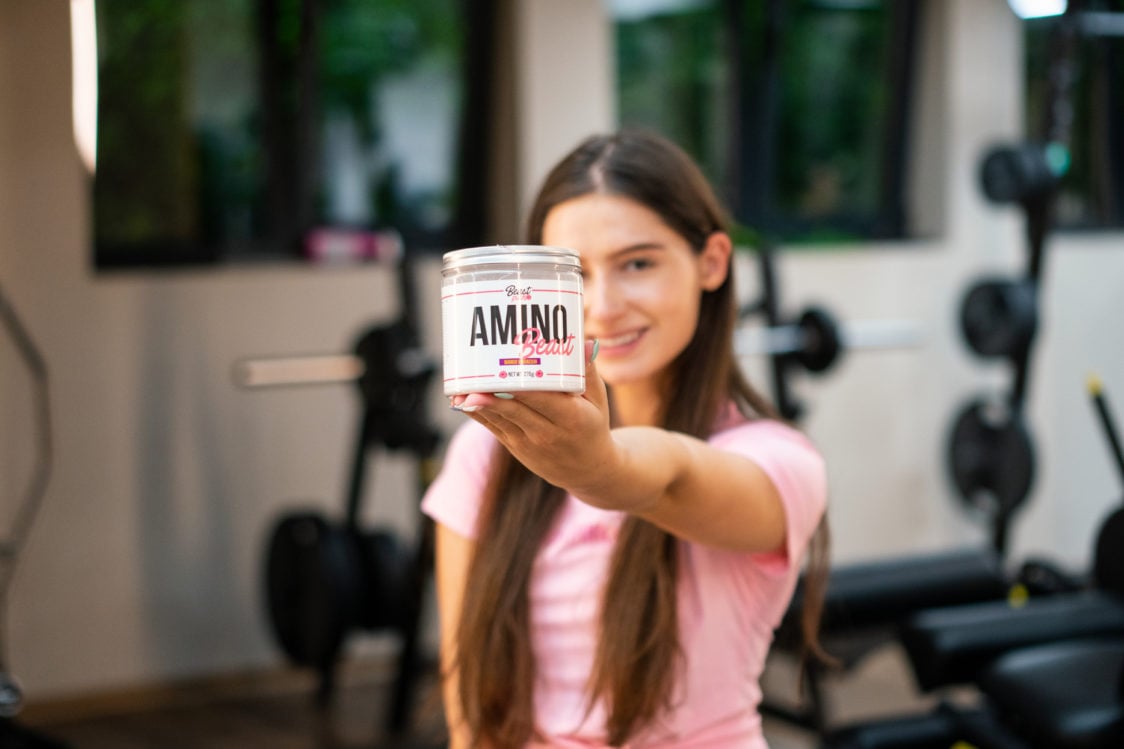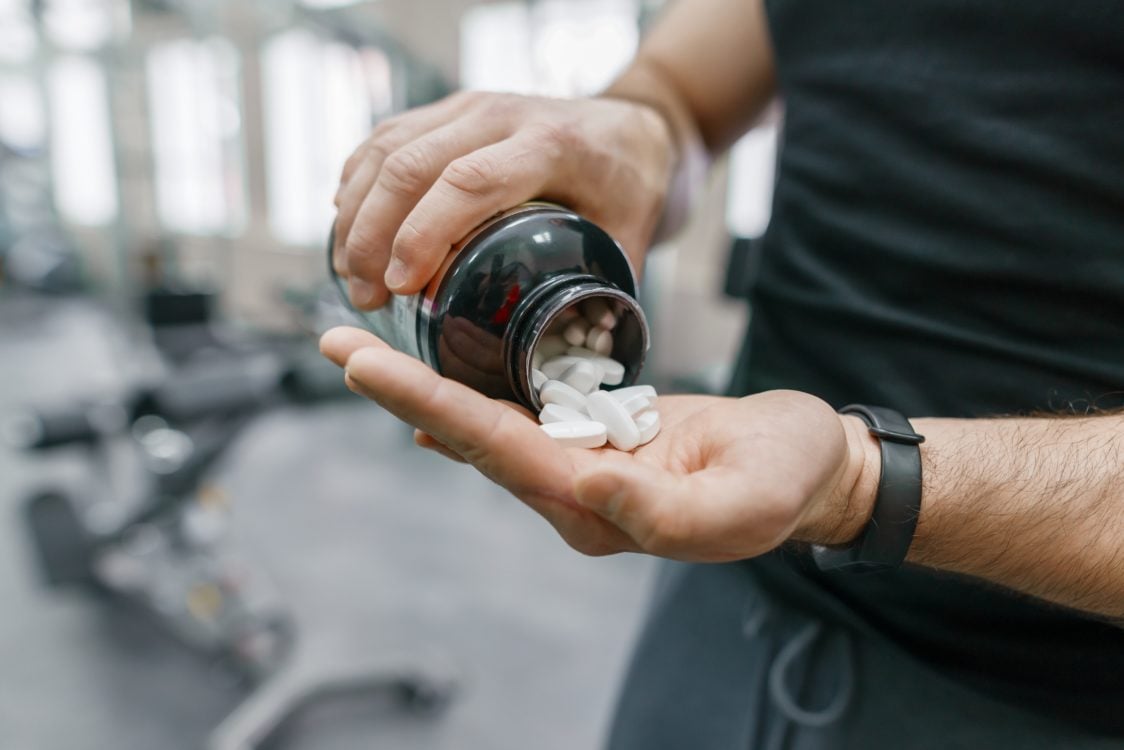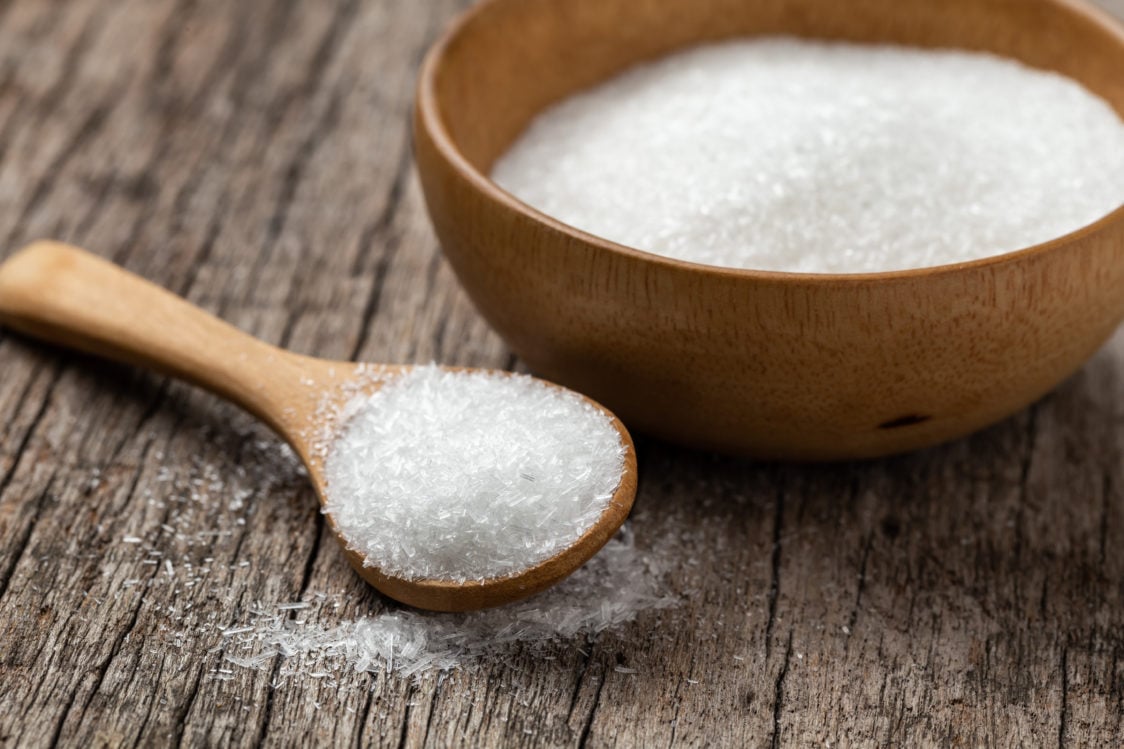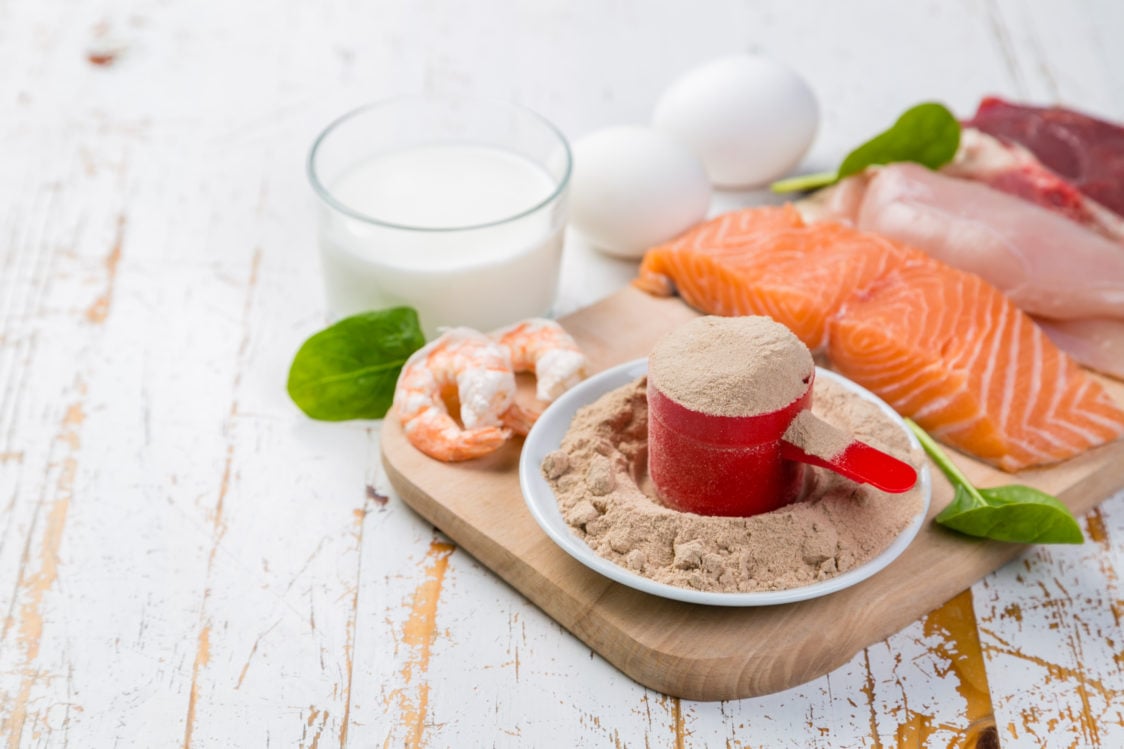Table of Contents
Amino acids are primarily the building blocks of proteins, but they also have a variety of functions in the body. Even the most basic processes, such as digestion or immune protection, would not function properly without them. An example is glutamine, which serves, among other things, as an energy source for some cells of the intestinal mucosa and the immune system. Together with BCAAs or arginine, these are also popular supplements among athletes. In today’s article you will read all the important things you ever wanted to know about amino acids, including their effect on athletic performance.
What are amino acids?
Amino acids (AAs) are the building blocks from which peptides and then proteins are formed. There are thousands of different types of amino acids. You can simply think of the interconnection of individual amino acids as a kind of Lego building block.
Each Lego brick can have a different shape, colour and size. If you want to build a spaceship, you have to place a certain Lego block in the right place. With a little imagination you can use the same bricks to build a house or even a car. It’s all in the placement that counts. The same applies to amino acids. Depending on the order and how they are linked together, a specific type of protein is formed.
If chemistry was one of your favourite subjects, you probably also wondered what the formula of amino acids is. Each AA molecule contains a carboxyl group (COO) and an amine group (NH2). This is where the name amino acid comes from. [1]

Classification of amino acids and their function in the body
In total, there are twenty types of amino acids that the body needs to build and repair body tissues, absorb nutrients, and other processes necessary for your health. Some must be taken in through food, others can be produced by your body, and then there are also amino acids that you only need to supplement at certain stages of life. Accordingly, they are categorised as essential, non-essential and semi-essential. [2]
What is the difference between the L and D forms of amino acids?
In general, amino acids are commonly found in the L or D form in nature. An example is L-Leucine, which is the mirror image of D-Leucine. They have an oppositely positioned amino group, which affects their use in the body. Only the L-form of amino acids, from which proteins and other necessary substances are formed, is of use to your body. [38]
1. Essential amino acids (EAA)
Without these amino acids, your body practically cannot do without them. It can’t produce them on its own, so therefore you are dependent on their intake from diet and supplements. There are a total of eight essential amino acids (EAA) and the body uses them for muscle regeneration, muscle mass formation, hormone synthesis, neurotransmitter synthesis, and they also produce some non-essential amino acids.
Sometimes histidine is also added to the list, but it is considered an essential amino acid only in childhood. In adulthood, our body can already produce it, so it is a semi-essential AMK.
In this section on essential amino acids, you will read about the following AAs:
1. Leucine
Leucine is the first of the trio of branched chain amino acids, which you probably know as BCAA (Branched Chain Amino Acids). They make up about 35% of all the essential amino acids in your body. They are most commonly associated with protecting muscle mass during exercise. And it is leucine that has the most to do with this. According to studies, it is able to activate the mTOR (Mammalian Target of Rapamycin) signalling pathway, which is involved at the beginning of the processes related to cell growth (muscle growth and anabolic processes) and muscle protein MPS (Muscle Protein Synthesis). [3, 39]
If you want to learn more about other interesting effects of leucine, you can find them in our article Leucine and its Effectivity on Muscle Growth and Recovery.

2. Valine
Valine is the second representative of BCAA, which also participates in the most basic processes in the body. These include energy production, protection of muscle mass from breakdown (catabolism) during energy deficiency and muscle growth. However, according to studies, it can also support the function of dendritic cells, which are an important link for immunity. [4, 40]
3. Isoleucine
Isoleucine is the third member of the BCAA family and, like its relatives, is associated with the protection and growth of muscle mass and energy metabolism. It has anti-catabolic effects and can thus contribute to protecting muscles from breaking down (used as an energy source). Perhaps behind this is its ability to increase the use of glucose as an energy source during exercise. [41]
It has also been shown in research to contribute to proper immune function. For example, through the activation of protective peptides (β-defensins). These can protect your body from attack by viruses and other pathogens. [5]

4. Methionine
Methionine is one of the sulphur-containing amino acids. In the body, it is not only used to make proteins, but also forms the non-essential amino acid cysteine. Together with glycine and arginine, it forms creatine, and another interesting fact is that it is also needed for the formation of carnitine. It also has an effect on fat metabolism, immune system function and can trigger the production of the body’s main antioxidant glutathione. Because of this, it is linked to protecting the body from oxidative stress. [6]
5. Threonine
Threonine, in turn, is most commonly associated with the formation of body tissue. It is one of the basic components of tooth enamel, the protein elastin and also has an effect on maintaining the integrity of the intestinal mucosa, thus supporting digestion and indirectly immunity. In addition, it is essential for the synthesis of other amino acids in the form of glycine and serine. [7]

6. Phenylalanine
The body also makes a number of important substances from this AA, such as the neurotransmitter dopamine or noradrenaline. It is also needed for the formation of the amino acid tyrosine. In the case of phenylalanine, there is also one very important thing to watch out for. There is a hereditary disease called phenylketonuria (PKU), in which phenylalanine accumulates in the body, resulting in delayed development in children. This condition is then managed primarily by a diet low in phenylalanine. [8]
7. Tryptophan
Tryptophan is another AA that is used in the body to synthesise neurotransmitters. In this instance, it is serotonin, which regulates appetite or mood. However, it is also at the origin of the production of the hormone melatonin, which in turn affects sleep. Therefore, in clinical practice, in the form of supplements, it is commonly used in the treatment of sleep or psychological problems. [9]
8. Lysine
Like methionine, lysine is needed for the formation of carnitine, which serves as a carrier of fatty acids (fats) to the cell’s power plants (mitochondria), where they are converted into energy. Lysine also plays a role in the absorption of calcium, which is crucial for healthy bones. According to research, it is even linked to the production of growth hormone, which has an effect on building muscle mass. That’s probably why it’s often found in supplements in combination with BCAAs. Interestingly, in a number of studies, it has helped people with recurrent cold sores (herpes simplex) reduce the symptoms and frequency of this skin problem. [10, 37]
2. Non-essential amino acids
As the name suggests, they are no longer indispensable for your body. It can produce them from essential or semi-essential amino acids or glucose. But this does not detract from their importance. They are involved in the construction of body tissue and are also involved in the most essential bodily functions, such as vitamin metabolism or digestion. [11]
In this section on non-essential amino acids, you will read about the following AAs:
1. Alanine
Alanine is one of the most abundant amino acids in skeletal muscle, where it also functions as a reserve energy source. It is also involved in the metabolism of vitamin B6 and glucose. It thereby helps maintain blood sugar (glucose) levels at normal levels. Last but not least, it is involved in the production of white blood cells, which are important for immune function. [12]
In addition to alanine, there is also the amino acid beta-alanine, which is a popular supplement among athletes. Unlike alanine, it does not form proteins in the body, but together with histidine it is used to synthesise carnosine. The latter helps to reduce muscle acidification during intense activity by binding hydrogen ions derived from lactic acid (lactate), which can ultimately lead to improved performance.
You can learn more about the effects of beta-alanine and its use in our article Beta-Alanine and Its Use in Sport.
You might be interested in these products:
2. Aspartic acid
Aspartic acid is involved in important processes in the body, such as hormone synthesis or nervous system function. In the ionised form of aspartate, it belongs among the excitatory neurotransmitters, which have stimulating effects on the nervous system. [13-14]
In dietary supplements, you may encounter it in the form of D-aspartic acid (DAA). The latter is notably associated with effects on testosterone levels and male fertility.
For more interesting information about D-aspartic acid, read our article D-Aspartic Acid or DAA – All You Need to Know.

3. Asparagine
Asparagine is an amino acid that is formed from aspartic acid. It plays an important role in the formation of glycoproteins (proteins with attached carbohydrates) and also binds to excess ammonia that is produced when proteins are broken down. It helps flush it out of the body and thus contributes to the body’s natural detoxification. [15]
4. Cysteine
Cysteine has an exceptional sulphur content, which allows it to form the amino acid taurine. Although it does not serve as a building block for proteins, it has antioxidant effects and may also influence energy production or calcium metabolism. In addition, cysteine is a key component of the antioxidant glutathione. As a result, it can help protect cells from oxidative stress. In dietary supplements, it is most commonly found in the form of N-acetyl L-cysteine (NAC). [16-17]
5. Glutamic acid
Glutamic acid is found in the body mainly in the form of glutamate. It is the most important excitatory neurotransmitter (activates the nervous system). In addition, it acts on specific taste cells on the tongue and produces the well-known umami taste. This is also why it is commonly added to foods as a flavour enhancer. [18]

6. Proline
Proline is important for maintaining cellular integrity and function. Together with glycine and hydroxyproline, it is one of the amino acids that make up collagen. It thus has an influence on the maintenance of skin, articular cartilage or tendon health. It is also associated with promoting wound healing. [19]
7. Serine
Serine is present in a high concentration in the cell wall and thus contributes to the maintenance of cell integrity. It is also important for digestion, as it forms the enzyme serine protease, which helps to break down proteins into simpler (easier to use) particles such as dipeptides, tripeptides and single amino acids. [20]

8. Glutamine
Glutamine is one of the most abundant AAs in the human body. Compared to other amino acids, it contains twice the amount of nitrogen, which is the basis of all protein peptide bonds in your tissues. It is essential for the production of white blood cells and cytokines, which are part of your body’s defence mechanisms (immune response) to hostile substances. It even serves as an energy source for some cells of the immune system and the intestinal mucosa. Moreover, it helps to keep the intestine intact and impermeable. For this reason, it is often used as a nutritional supplement for Leaky Gut Syndrome. [23]
This is why it is often used by runners, cyclists and other athletes who train for several hours and want to ensure they maintain optimal amounts of this AA in their bodies. [23]
Learn more about the effects of glutamine in our article Glutamine Is Essential for Athletes.
9. Glycine
Important compounds such as glutathione or creatine are formed from glycine in the body. It also acts as a neurotransmitter and is a component of collagen. Due to its properties, it is primarily associated with joint health. According to studies, its supplementation can also help improve sleep. Increased intake is sometimes recommended during pregnancy. [24]
10. Tyrosine
Your body can make tyrosine from phenylalanine. It has a particular effect on brain function, as it forms neurotransmitters such as dopamine, adrenaline and noradrenaline, which help you cope with stressful situations. However, during mentally and physically demanding times, their need is greater and thus the demands on tyrosine intake also increase. In addition, thyroid hormones are also produced from this AA. [25]
3. Semi-essential amino acids
These AAs are non-essential under normal conditions. However, there may be situations in which they become essential and need to be replenished. This happens especially during a period of growth, during pregnancy, during major stress, during strenuous sports activities or after injuries. However, these substances can also be lacking during long-term adherence to low-energy diets or inadequate nutrition (malnutrition).
In this section on semi-essential amino acids, you will read about the following AAs:
1. Arginine
Nitric oxide (NO) is formed in the body from arginine, which is a signalling molecule for blood vessel dilation (vasodilation). Due to its vasodilating effect, it can increase blood flow to the muscles, which can result in better oxygen and nutrient supply to the muscles. Through this, it can affect blood pressure or muscle recovery. In the form of nutritional supplements, it is particularly popular with athletes before training. However, the influence on the dilation of blood vessels and better blood flow is also the reason arginine is also added to erection support supplements. But it should not be forgotten that, like glycine and methionine, it is needed in the body for the synthesis of creatine. [21-22]
2. Histidine
Histidine is a precursor of histamine, which is crucial in the body for the triggering of an allergic reaction. It also gives rise to the aforementioned carnosine. It is semi-essential, as your body cannot produce it in infancy. The same is true for people with uraemia (uremic syndrome) and the body’s natural production of histamine may decline with age. [26]
Each of the above twenty amino acids thus has a specific function in the body. We have by no means mentioned all the processes in which these substances are involved. What is certain, however, is that without exception they are all needed to maintain health.

Can amino acids boost sports performance?
For some amino acids we have already mentioned their possible influence on muscle mass, energy metabolism or oxygen supply to the muscles. Now we’re going to take a look at BCAAs, glutamine and arginine to see what studies have to say about them in relation to sport.
1. BCAAs can contribute to muscle growth
- Leucine, isoleucine and valine have the ability to prevent the loss (degradation) of muscle mass during strenuous exercise.
- During endurance activities, they can in turn serve as a source of energy, leading to the sparing of glycogen stores and prolonged performance.
- During performance, they can help delay fatigue and reduce perceived exertion.
- After strength training, they may support anabolic processes associated with muscle fibre repair and growth.
- According to studies, leucine has the greatest effect on muscle protein synthesis (MPS), or the process of muscle mass formation.
- For muscle recovery and growth, however, it is most effective to take a sufficient amount of all the essential amino acids after training. Ideally in the form of protein, which can then be enriched with BCAAs or leucine alone to increase its potential. [27]
If your goal is muscle growth, you should not miss our article 10 Nutritional and Training Tips for Maximum Muscle Growth.

2. Glutamine can promote the utilisation of the stored carbohydrate glycogen
- Glutamine is a source of energy for some cells of the immune system, which takes a beating during prolonged activities. Its intake could thus lead to the preservation of immune functions during a demanding workout. However, the results of studies on the effect of glutamine on immunity in athletes are yet unclear and have yet to wait for confirmation of this effect.
- Glutamine may also promote the use of muscle glycogen as an energy source, leading to longer maintenance of performance and delaying fatigue. [28]
If you’re into endurance sports and you’re wondering which other supplements could help your performance, check out our article 11 of the Best Supplements for Running, Cycling and Other Endurance Sports.
3. Arginine can aid in breaking down lactate in the muscles
- Supplementation with arginine before exercise can lead to less lactic acid (lactate) build-up in the muscles, which can be reflected in better results even during intense exercise. It has also been found to contribute to more efficient recovery of creatine and thus energy in the form of ATP. [29]
- Arginine also had a positive effect on the athletes’ VO2max level, which is one indicator of athletic performance. [30]
If you are wondering about other interesting effects of arginine, read our article Arginine and its 8 Proven Benefits for Health and Athletes.
How to supplement amino acids?
Amino acids are a staple in our diet. You can find them especially in foods with a higher proportion of protein. The quality of these sources is determined by whether they contain all the essential AAs in the optimal ratio. You can also increase your intake of AAs by taking nutritional supplements.
1. Complete sources of amino acids
- Contain essential amino acids in optimal amounts and ratios.
- These include mainly animal foods such as meat, fish, eggs, dairy products or whey protein.
- Some plant sources, such as soy (tofu, tempeh), chickpeas or quinoa also come close.
For additional food sources of protein, check out our article Foods that Easily Add Protein to Your Diet.

2. Incomplete sources of amino acids
- They do not have a balanced amount of essential amino acids, which reduces their quality.
- Incomplete sources include lentils, peas, rice or nuts and most other plant foods.
Even in plant foods you can find all the EAAs, but often not in sufficient quantities to meet all your body’s needs. These missing AAs are called limiting amino acids. Fortunately, each group of plant foods lacks different amino acids, so by combining plant sources appropriately you can almost get rid of this deficiency. For example, cereals are deficient in the amino acid lysine, while legumes lack methionine. By combining them, you get closer to an animal protein quality.
If you are wondering which plant foods are rich in protein, read our article What are the Best Sources of Plant Protein and Why Include Them in Your Diet?
Limiting amino acids in plant foods
Limiting AA | What foods to combine them with to replenish the limiting AAs? | |
|---|---|---|
| Grains | lysine | legumes |
| Legumes | methionine | grains, nuts, seeds |
| Nuts and seeds | lysine | legumes |
How to supplement amino acids?
You can also increase your amino acid intake with more concentrated supplements. You can choose from single or multi-ingredient amino acids. Most often, they come in the form of soluble powder, tablets or capsules.
1. Single-chain amino acids
If you want to increase your intake of just some amino acids, you can try a single-ingredient supplement. Alternatively, use a few supplements to get a complex product according to your needs. What is the recommended intake of the most commonly used amino acids?
- Arginine in the amount of 3-6 g before exercise. More than 10 g at one time can cause digestive problems, so it is better to divide the higher amount into several daily servings. [31]
- Glutamine in the form of l-glutamine at a serving of 5 g per day. [32]
- Leucine at a serving of 2-5 g alone, with a meal deficient in this amino acid or as part of a post-workout drink to increase anabolic potential. [33]
- Cysteine in the form of N-acetyl L-cysteine in a range of 600-1800 mg. [34]
- Aspartic acid in the form of D-aspartic acid in a daily serving of 2000-3000 mg. [35]
- Lysine is taken at a serving of up to 2 g per day divided into several servings with meals. This amount is recommended for people who frequently develop cold sores (herpes simplex). [37]

2. Complex amino acids
In complex products containing amino acids, you will most often find BCAAs or eight EAAs, which are sometimes supplemented with non-essential amino acids and other substances. An example is the product ProAMINO, which contains nine AAs, caffeine and extracts from green tea and coffee. ProAMINO Stim-free on the other hand, is free of stimulants, but has six vitamins in its formula.
- BCAAs are normally taken at a serving of 20 g, with the important detail being that it should contain a higher ratio of leucine compared to isoleucine and valine, for example 4:1:1 in favour of leucine. [36]
- EAAs have a recommended serving of 10-12 g.

Do amino acids have any side effects?
As long as you take amino acid supplements in reasonable amounts and according to the instructions on the label, you should not experience any side effects. These will only occur in exceptional cases and in people who have a hypersensitivity or allergy to the ingredients contained. However, abdominal pain and indigestion may occur with excessive intake. Remember that this is only a nutritional supplement and a varied diet rich in protein should form the basis of your amino acid intake.
What should you remember?
From today’s article you have learned that amino acids are not just a material for building muscle mass. In the body, they make important enzymes, hormones or neurotransmitters, without which your body would barely function properly. They are involved in maintaining healthy skin, joints and the entire musculoskeletal system. They are also used whenever something in the body needs to be repaired or healed. Therefore, it is important to ensure their adequate intake, especially of the essential ones, from your diet or through supplements.
If you liked our article and found it informative, please share it with your friends who will be interested to learn more about the interesting effects of amino acids.
[1] Lopez, M. J., & Mohiuddin, S. S. Biochemistry, Essential Amino Acids. – https://www.ncbi.nlm.nih.gov/books/NBK557845/
[2] Knapp, S. Amino Acids—Benefits, Structure & Function. – https://biologydictionary.net/amino-acids/
[3] Pedroso, J. A. B., Zampieri, T. T., & Jose Donato, J. Reviewing the Effects of l-Leucine Supplementation in the Regulation of Food Intake, Energy Balance, and Glucose Homeostasis. – https://doi.org/10.3390/nu7053914
[4] Study.Com. Valine Structure, Function & Degradation . – https://study.com/academy/lesson/valine-function-structure-degradation.html
[5] Gu, C., Mao, X., Chen, D., Yu, B., & Yang, Q. Isoleucine Plays an Important Role for Maintaining Immune Function. – https://doi.org/10.2174/1389203720666190305163135
[6] Martínez, Y., Li, X., Liu, G., Bin, P., Yan, W., Más, D., Valdivié, M., Hu, C.-A. A., Ren, W., & Yin, Y. The role of methionine on metabolism, oxidative stress, and diseases. – https://doi.org/10.1007/s00726-017-2494-2
[7] Study.Com. Threonine – https://study.com/learn/lesson/threonine-amino-acid-structure-benefits.html
[8] ScienceDirect Topics. Phenylalanine—An overview – https://www.sciencedirect.com/topics/agricultural-and-biological-sciences/phenylalanine
[9] Kałużna-Czaplińska, J., Gątarek, P., Chirumbolo, S., Chartrand, M. S., & Bjørklund, G. How important is tryptophan in human health? – https://doi.org/10.1080/10408398.2017.1357534
[10] ResearchGate. Wheat Bread: Potential Approach to Fortify its Lysine Content. – https://www.researchgate.net/publication/331427516_Wheat_Bread_Potential_Approach_to_Fortify_its_Lysine_Content
[11] ScienceDirect Topics. Nonessential Amino Acid—An overview. – https://www.sciencedirect.com/topics/neuroscience/nonessential-amino-acid
[12] PubChem. Alanine. – https://pubchem.ncbi.nlm.nih.gov/compound/5950
[13] Study.Com. Aspartic Acid: Structure, Benefits & Uses. – https://study.com/academy/lesson/what-is-aspartic-acid-production-structure-benefits.html
[14] Dingledine, R., & McBain, C. J. Glutamate and Aspartate Are the Major Excitatory Transmitters in the Brain. Basic – https://www.ncbi.nlm.nih.gov/books/NBK28252/
[15] PubChem. Asparagine. – https://pubchem.ncbi.nlm.nih.gov/compound/6267
[16] Examine. Taurine—Health benefits, dosage, safety, side-effects, and more. – https://examine.com/supplements/taurine/
[17] ScienceDirect Topics. Cysteine - An overview. – https://www.sciencedirect.com/topics/chemistry/cysteine
[18] Brosnan, J. T., & Brosnan, M. E. Glutamate: A truly functional amino acid. – https://doi.org/10.1007/s00726-012-1280-4
[19] Wu, G., Bazer, F. W., Burghardt, R. C., Johnson, G. A., Kim, S. W., Knabe, D. A., Li, P., Li, X., McKnight, J. R., Satterfield, M. C., & Spencer, T. E. Proline and hydroxyproline metabolism: Implications for animal and human nutrition. – https://doi.org/10.1007/s00726-010-0715-z
[20] PubChem. Serine. – https://pubchem.ncbi.nlm.nih.gov/compound/5951
[21] J, A. Arginine: Clinical potential of a semi-essential amino acid. – https://pubmed.ncbi.nlm.nih.gov/12495375/
[22] Thomas Solomon, P. Arginine Research Analysis. – https://examine.com/supplements/arginine/
[23] Cruzat, V., Macedo Rogero, M., Noel Keane, K., Curi, R., & Newsholme, P. Glutamine: Metabolism and Immune Function, Supplementation and Clinical Translation. – https://doi.org/10.3390/nu10111564
[24] Kamal Patel, M. P. H. Glycine Research Analysis. – https://examine.com/supplements/glycine/
[25] Bill Willis, P. L-Tyrosine Research Analysis. – https://examine.com/supplements/l-tyrosine/
[26] Zadák, Z. Výživa v intenzivní péči: 2., rozšířené a aktualizované vydání.
[27] Jäger, R., Kerksick, C. M., Campbell, B. I. et al. International Society of Sports Nutrition Position Stand: Protein and exercise. – https://doi.org/10.1186/s12970-017-0177-8
[28] Coqueiro, A. Y., Rogero, M. M., & Tirapegui, J. Glutamine as an Anti-Fatigue Amino Acid in Sports Nutrition. – https://doi.org/10.3390/nu11040863
[29] Viribay, A., Burgos, J., Fernández-Landa, J., Seco-Calvo, J., & Mielgo-Ayuso, J. Effects of Arginine Supplementation on Athletic Performance Based on Energy Metabolism: A Systematic Review and Meta-Analysis. – https://doi.org/10.3390/nu12051300
[30] Pahlavani, N., Entezari, M. H., Nasiri, M., Miri, A., Rezaie, M., Bagheri-Bidakhavidi, M., & Sadeghi, O. The effect of L-arginine supplementation on body composition and performance in male athletes: A double-blinded randomized clinical trial. – https://doi.org/10.1038/ejcn.2016.266
[31] Examine. Arginine—Health benefits, dosage, safety, side-effects, and more . – https://examine.com/supplements/arginine/
[32] Examine. Glutamine—Health benefits, dosage, safety, side-effects, and more. – https://examine.com/supplements/glutamine/#dosage-information
[33] Examine. Leucine-Health benefits, dosage, safety, side-effects, and more. – https://examine.com/supplements/leucine/
[34] Tenório, M. C. dos S., Graciliano, N. G., Moura, F. A., Oliveira, A. C. M. de, & Goulart, M. O. F. N-Acetylcysteine (NAC): Impacts on Human Health. – https://doi.org/10.3390/antiox10060967
[35] Examine. D-Aspartic Acid—Health benefits, dosage, safety, side-effects, and more.– https://examine.com/supplements/d-aspartic-acid/
[36] Frank, K. Branched-Chain Amino Acids Research Analysis. – https://examine.com/supplements/branched-chain-amino-acids/
[37] Examine. Research Breakdown on Lysine.– https://examine.com/supplements/lysine/research/#PlYKyQm-sources-and-structure-1
[38] Lakna. What is the Difference Between L and D Amino Acids. – https://pediaa.com/what-is-the-difference-between-l-and-d-amino-acids/
[39] Neinast, M., Murashige, D., & Arany, Z. Branched Chain Amino Acids. – https://doi.org/10.1146/annurev-physiol-020518-114455
[40] Examine. Research Breakdown on Valine.– https://examine.com/supplements/valine/research/#EJ3b3Qv-skeletal-muscle-and-performance
[41] Kamal Patel, M. P. H. Isoleucine Research Analysis. – https://examine.com/supplements/isoleucine/
[42] STAFF, A.S.N. – https://nutrition.org/protein-complementation/


Add a comment